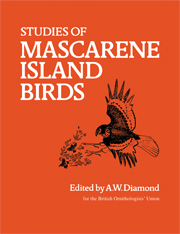Book contents
- Frontmatter
- Contents
- List of contributors
- Foreword
- Introduction
- I The native avifauna of the Mascarene Islands
- 1 An ecological history of the Mascarene Islands, with particular reference to extinctions and introductions of land vertebrates
- 2 The fossil record
- 3 Vocalisations of the endemic land-birds of the Mascarene Islands
- II The surviving native birds of Mauritius
- 4 The ecology of the smaller land-birds of Mauritius
- 5 The larger land-birds of Mauritius
- III The surviving native birds of Réunion and Rodrigues
- 6 The ecology of the surviving native land-birds of Réunion
- 7 Notes on the nesting of Procellariif ormes in Réunion
- 8 Observations on the surviving endemic birds of Rodrigues
- IV Measurements and weights
- 9 Measurements and weights of the surviving endemic birds of the Mascarenes and their eggs
- References
- Index
2 - The fossil record
Published online by Cambridge University Press: 04 August 2010
- Frontmatter
- Contents
- List of contributors
- Foreword
- Introduction
- I The native avifauna of the Mascarene Islands
- 1 An ecological history of the Mascarene Islands, with particular reference to extinctions and introductions of land vertebrates
- 2 The fossil record
- 3 Vocalisations of the endemic land-birds of the Mascarene Islands
- II The surviving native birds of Mauritius
- 4 The ecology of the smaller land-birds of Mauritius
- 5 The larger land-birds of Mauritius
- III The surviving native birds of Réunion and Rodrigues
- 6 The ecology of the surviving native land-birds of Réunion
- 7 Notes on the nesting of Procellariif ormes in Réunion
- 8 Observations on the surviving endemic birds of Rodrigues
- IV Measurements and weights
- 9 Measurements and weights of the surviving endemic birds of the Mascarenes and their eggs
- References
- Index
Summary
Chapter 1 has outlined the extent to which many endemic Mascarene Island birds have become extinct, probably during the last 300 years since man arrived on the islands. Thirty extinct species are recognised today (Cowles in press), but of these only five are known from skins preserved in museums and institutions throughout the world. Four of these species, the Mauritian Blue Pigeon Alectroenas nitidissima, the Mascarene Parrot from Réunion Mascarinus mascarinus, the Rodrigues Parakeet Psittacula exsul and the contentious Leguat's Starling Necropsar (Orphanopsar) leguati of unknown locality, are represented by a total of only eight skins. The Reunion Crested Starling Fregilupus varius was better represented by 24-25 skins, all documented by Hachisuka (1953), although fewer survive today (Chapter 1). The remaining 25 extinct species are known only from fossil bones discovered in caverns and deposits on the three islands. In number these range to well over 200 elements for the better known Solitaire of Rodrigues Pezophaps solitaria and perhaps the Mauritius Dodo Raphus cucullatus, but the remaining species are unfortunately known from very few bones or bone fragments.
Identifications based on the osteological evidence are in some instances substantiated by field descriptions and illustrations in journals of seventeenth- century voyagers to the islands. The visitors who added notably to early ornithological history were Leguat (1708), on Rodrigues in 1691, Dubois (1674), on Reunion 1671-2, and Van Neck, on Mauritius 1598 or 1599 (see Strickland 1848). The other voyagers were listed by Hachisuka (1953) and Cheke (Chapter 1). These brief accounts of the flora and fauna of the islands were compiled by people with little ornithological knowledge, but they do provide a most valuable and historical record of the lost avifauna of the islands.
- Type
- Chapter
- Information
- Studies of Mascarene Island Birds , pp. 90 - 100Publisher: Cambridge University PressPrint publication year: 1987
- 10
- Cited by



